A mannequin of this put up was initially printed on TKer.co.
shares rallied final week. The S&P 500 surged 4.7% in what was the largest weekly obtain since June. The index is now up 4.9% from its October 12 closing low of three,577.03. however, it’s nonetheless down 21.eight% from its January three closing extreme of 4,796.fifty six.
When markets are as unstable as they’ve been, it’s simple to get caught up in all of the issues which might be going proper or mistaken inside the interim.
And whereas there’s nothing mistaken with holding current on the current, that simply is not the best mindset for prolonged-time period buyers in shares.
“do not pay money for the current,” Stanley Druckenmiller, the legendary hedge fund supervisor presently working Duquesne household office, acknowledged. “the current simply isn’t what strikes inventory prices.”
Druckenmiller famous that that is his No. 1 piece of advice for mannequin new buyers.
In a Sept. 22 episode of the “How Leaders Lead” podcast, Druckenmiller expanded on this (through The Transcript):
“I found this style again inside the 70s from my mentor [Speros] Drelles. i used to be a chemical analyst. When should you buy chemical corporations? conventional Wall avenue is when earnings are good. properly, you needn’t buy them when earnings are good, as a consequence of what are they doing when their earnings are good? They exit and broaden performance. Three or 4 years later, there’s overcapacity and in addition they’re shedding money. What about after they’re shedding money? properly, then they’ve stopped constructing performance. So three or 4 years later, performance can have shrunk and their revenue margins is inclined to be approach up. So, you on a daily basis want to variety of think about the world the approach by which it should be in 18 to 24 months versus now. whereas you buy it now, you are procuring for into each fad each second. Whereas whereas you envision the prolonged time period, you are attempting to think about how that is inclined to be mirrored in a single other approach in safety prices.”
that is theoretically sound as precept says the worth of a inventory ought to mirror the current worth of a agency’s future money flows.
Druckenmiller is talking about choosing shares. however i really feel his nonetheless serves as a very good framework for broadly diversified buyers processing macro knowledge coming from financial knowledge and earnings bulletins.
The labor market is extremely effective 💪
One large theme of late has been the power of the labor market. particularly, the elevated stage of job openings alerts the want to lease, and the depressed stage of layoff exercise alerts the will to dangle on to workers.
take into account these quotes from current earnings calls (through The Transcript and RBC Capital Markets):
-
“i would notice at this level, based mostly on our Q3 efficiency, now we have seen web hiring amongst our clients. So, now we have not but seen an emergence of recessionary affect in our industrial book of enterprise.” – UnitedHealth Group
-
“We’re seeing constructive staffing tendencies with eleven straight weeks of web pharmacist head depend will enhance.” – Walgreens Boots Alliance
-
“we do not make important cutbacks throughout the plant…we do not see any purpose for fantastic draconian measures.“ – Morgan Stanley
Bloomberg reported that Goldman Sachs, Morgan Stanley, Citigroup, JPMorgan Chase, and financial institution of America all elevated their headcounts in Q3.
equally, the previous week’s extreme-stage financial studies broadly confirmed these anecdotes. preliminary claims for unemployment insurance coverage advantages fell final week and proceed to pattern at low ranges. The Federal Reserve’s October Beige book acknowledged that employment “continued to rise at a modest to common tempo in most Districts.“ Manufacturing enterprise surveys from the NY Fed and Philly Fed every indicated employment was up of their respective areas in October.
What all this staffing means for the prolonged time period 🤔
The resilient labor market means that demand inside the financial system continues to be strong.
however that’s the current.
What with regard to the prolonged time period? What does this imply 18 to 24 months down the highway?¹
i really feel there are at the least two primary eventualities to suppose about.
-
Bearish state of affairs: The financial lull we’re in in the end evolves into recession and now we have an prolonged interval of weak demand. corporations which might be presently growing hiring or refusing to layoff workers might see a sharp drop in earnings as weak income runs into extreme labor prices, and revenue margins get crushed.
-
Bullish state of affairs: The financial lull we’re in proves brief-lived, and progress quickly accelerates as quickly as extra. corporations that held on to workers or grew head counts at this time might not want to compete aggressively for workers in what should be an more and more aggressive labor market. as a consequence of they’ve already obtained further performance, these corporations will revenue from working leverage as income progress comes with growing revenue margins, which amplifies earnings progress.
What truly occurs relies upon on the place the financial system heads, which itself simply isn’t an simple factor to foretell.
however I can’t assist however suppose that given the current state of issues, the outlook favors the extra bullish state of affairs. Why? as a consequence of the message from the financial knowledge and agency America is that demand continues to outpace the performance to current. take into account this quote from the Fed’s October Beige book: “general labor market situations remained tight, although half of Districts famous some easing of hiring and/or retention difficulties. rivals for workers has led to some labor poaching by rivals or competing industries ready to current greater pay.“
And take into account this from Domino’s: “Staffing stays a constraint, however my confidence in our means to resolve lots of our supply labor challenges ourselves has grown over the previous few quarters.”
So demand should fall significantly earlier than corporations discover themselves with an extreme quantity of costly idle labor.
Let’s test again in 18 to 24 months.
the underside line: shares are a discounting mechanism, pricing in what’s anticipated to happen and by no means what’s presently taking place. whether or not it’s 18-24 months out or 20 years out, being inside the inventory market is about betting on a better future that has but to be realized and priced in. Now, it’s not significantly clear what’s to get back in 18-24 months. (The lesson of the previous 18-24 months is that issues can definitely go mistaken.) however prolonged-time period historic previous might be very fixed in educating us that the prolonged-time period future on a daily basis seems to be greater than what we’re experiencing at this time.
–
extra from TKer:
Reviewing the macro crosscurrents 🔀
there have been a pair of notable knowledge factors from final week to suppose about:
🚨 Recession warning signal. The convention Board’s main financial Index2 fell in September. The six-month common change was -zero.5%, a studying that is traditionally associated to recessions. From The convention Board’s Ataman Ozyildirim: “The US LEI fell as quickly as extra in September and its persistent downward trajectory in current months suggests a recession is more and more seemingly earlier than yearend. The six-month progress price of the LEI fell deeper into destructive territory in September, and weaknesses amongst the numerous main indicators had been widespread. Amid extreme inflation, slowing labor markets, rising fees of curiosity, and tighter credit rating situations, The convention Board forecasts exact GDP progress is inclined to be 1.5% 12 months-over-12 months in 2022, earlier than slowing further inside the important half of subsequent 12 months.”
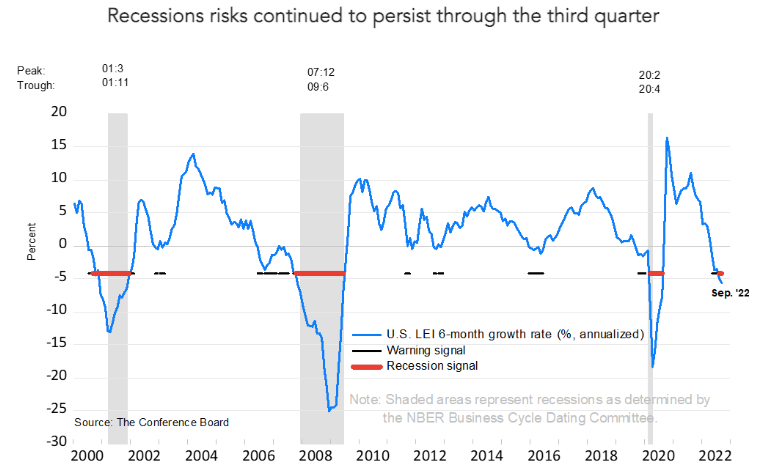
in the meantime, Bloomberg economists estimate there’s a “one hundred%” probability that the U.S. financial system can have entered a recession by October 2023.
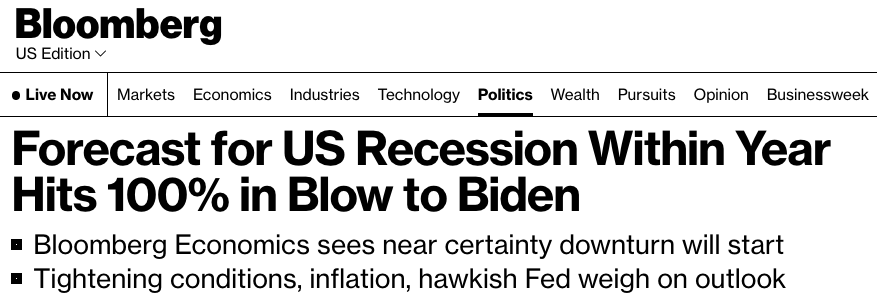
📈 Mortgage fees hold climbing. in accordance with Freddie Mac, the frequent 30-12 months mounted-price mortgage rose to six.ninety 4%, the best stage since April 2002.
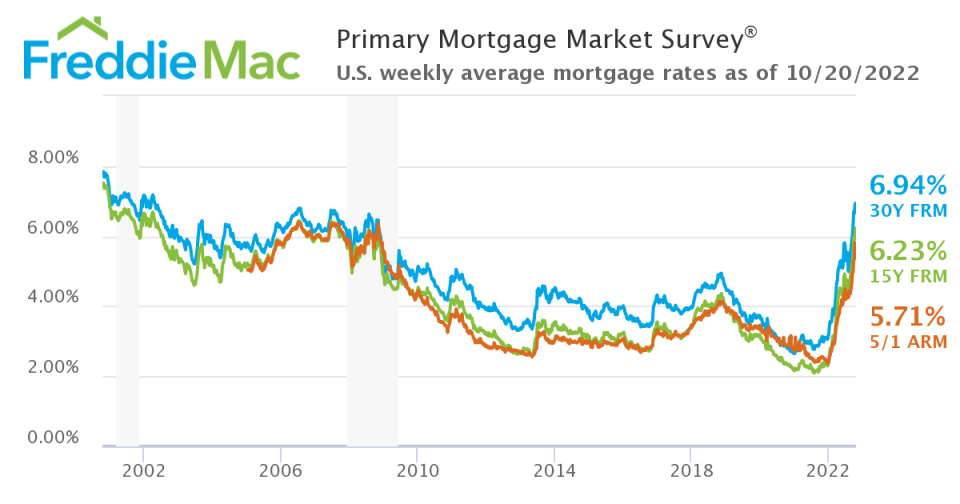
📉 $2,500 month-to-month mortgage payment will get you much less. Surging mortgage fees and nonetheless-extreme residence prices have made procuring for a residence unaffordable for lots of of. in accordance with Bloomberg’s Michael McDonough, a $2,500 month-to-month mortgage payment might get you a $756k residence in February 2021. at this time, it will get you a $455k residence.
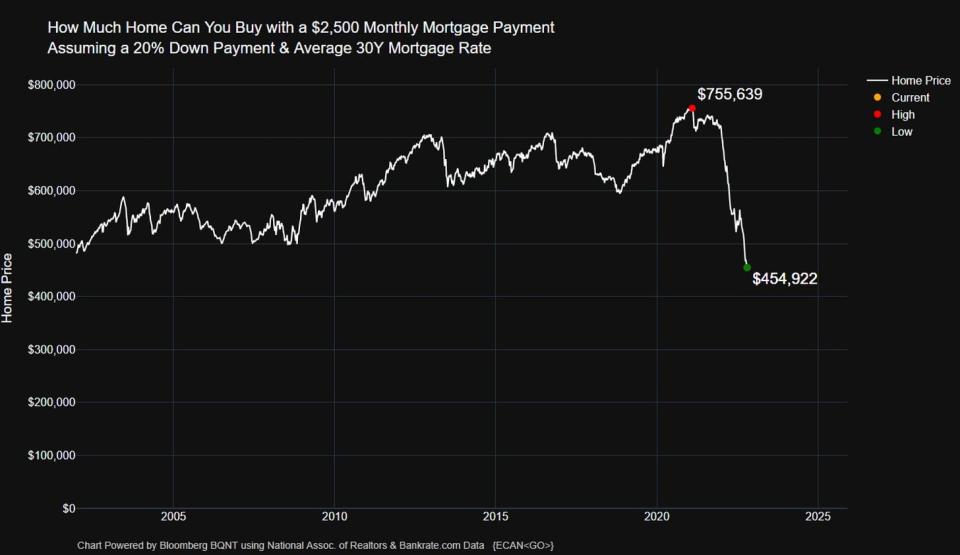
🏘 residence gross sales proceed to fall. in accordance with the nationwide affiliation of Realtors, gross sales of beforehand owned properties fell 1.5% in September to an annual price of 4.seventy a million models. From NAR chief economist Lawrence Yun: “The housing sector continues to endure an adjustment attributable to regular rise in fees of curiosity, which eclipsed 6% for 30-12 months mounted mortgages in September and are actually approaching 7%. costly areas of the nation are particularly feeling the pinch and seeing greater declines in gross sales.“
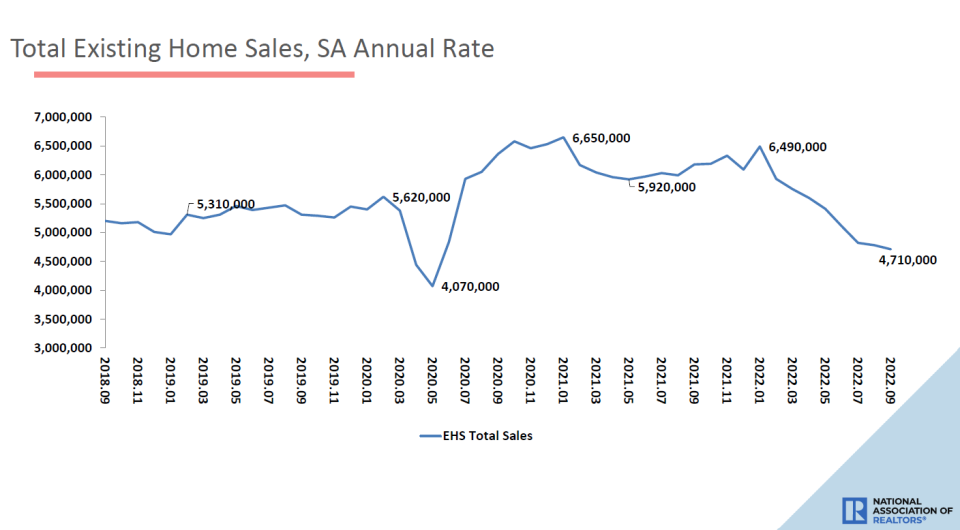
🏘 residence prices proceed to fall. The median worth of properties supplied fell to $384,800 in September, down from the June extreme of $413,800. however, the median worth continues to be eight.4% greater from final 12 months’s stage. to raised understand why this authorities inflation knowledge appear to lag these tendencies, be taught this.
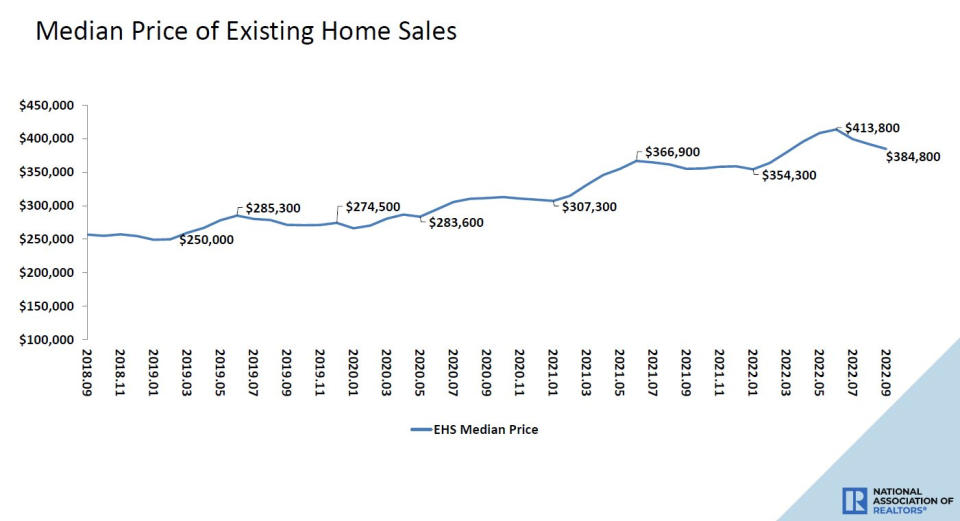
🔨 residence enchancment continues to relax. in accordance with the Census Bureau, the tempo of housing begins September fell eight.1% from August and seven.7% from 12 months in the past ranges. The tempo of latest constructing permits elevated 1.4% from the month prior, however was down three.2% from a 12 months in the past.
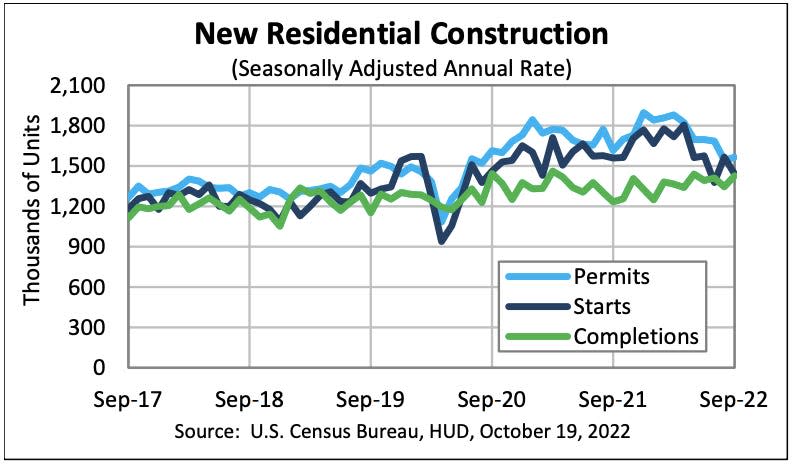
🛠 Builder sentiment goes deeper into the dumps. From the NAHB: “In an further signal that rising fees of curiosity, constructing supplies bottlenecks and elevated residence prices proceed to weaken the housing market, builder sentiment fell for the tenth straight month in October and site visitors of potential patrons fell to its lowest stage since 2012 (excluding the two-month interval inside the spring of 2020 initially of the pandemic).“ From NAHB chief economist Robert Dietz: “whereas some analysts have suggested that the housing market is now extra ‘balanced,’ the very actuality is that the homeownership price will decline inside the quarters forward as greater fees of curiosity and ongoing elevated enchancment prices proceed to value out a quantity of potential patrons.“
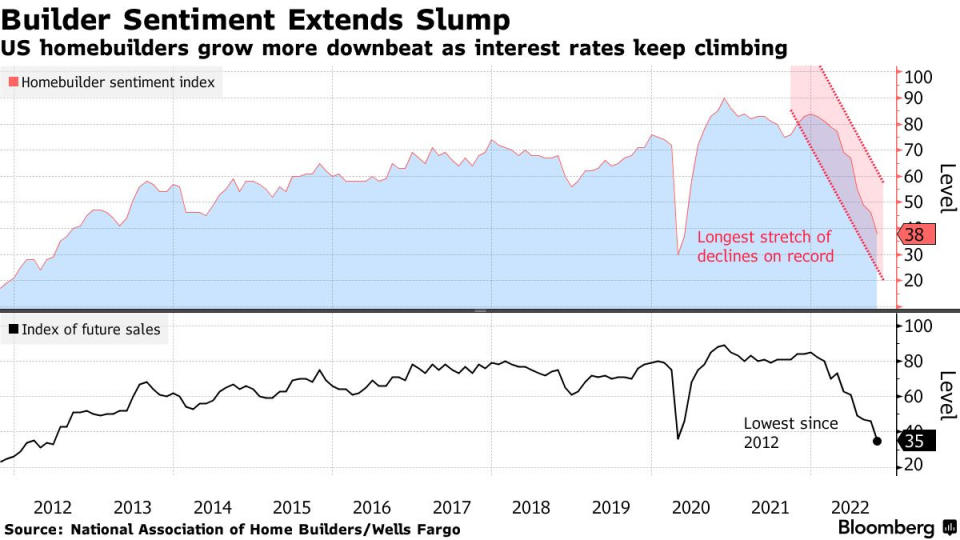
🛠 Manufacturing has been holding up. Industrial manufacturing exercise elevated by zero.4% month over month in September.

🛠 however manufacturing surveys are extra cautious. in accordance with the mannequin manhattan Fed’s October Empire State Manufacturing Survey, manufacturing exercise is contracting inside the mannequin manhattan space.
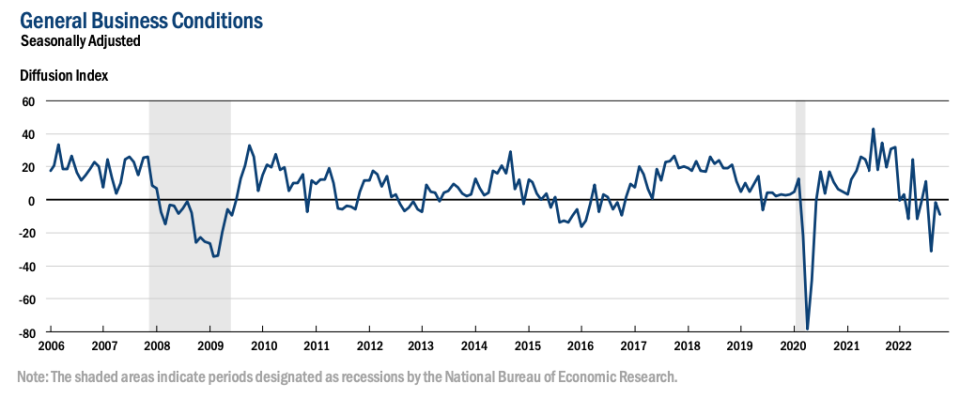
And in accordance with the Philly Fed’s October Manufacturing enterprise Outlook Survey, manufacturing exercise is contracting inside the Mideast U.S.
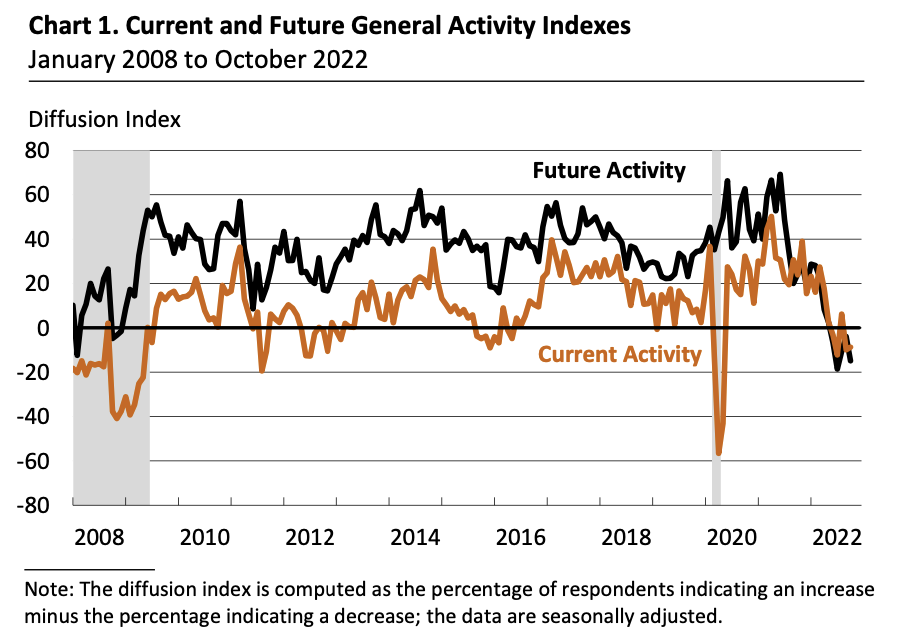
right here’s JPMorgan on the divergence between the exhausting industrial manufacturing knowledge and the gentle manufacturing survey knowledge: “whereas previous expertise suggests this hole is almost definitely to close with exercise sinking to mirror the message from the surveys — all of the extra so given the tightening of financial situations — the engaging assist from world items demand gives us pause.“
💼 Unemployment claims stay low. preliminary claims for unemployment advantages rose to 214,000 in the course of the week ending Oct. 15, down from 226,000 the week prior. whereas the quantity is up from its six-decade low of 166,000 in March, it stays shut to ranges seen all by instances of financial progress.
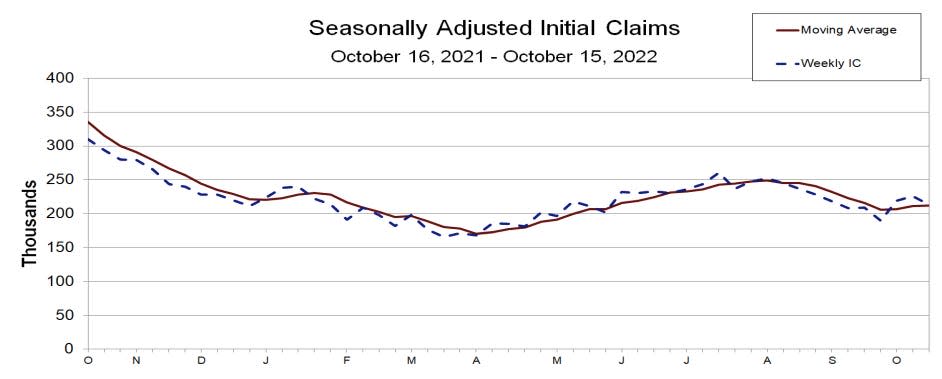
👍 Small companies plan to lease. in accordance with BofA, a rising proportion of small enterprise householders plan to lease over the subsequent 12 months.
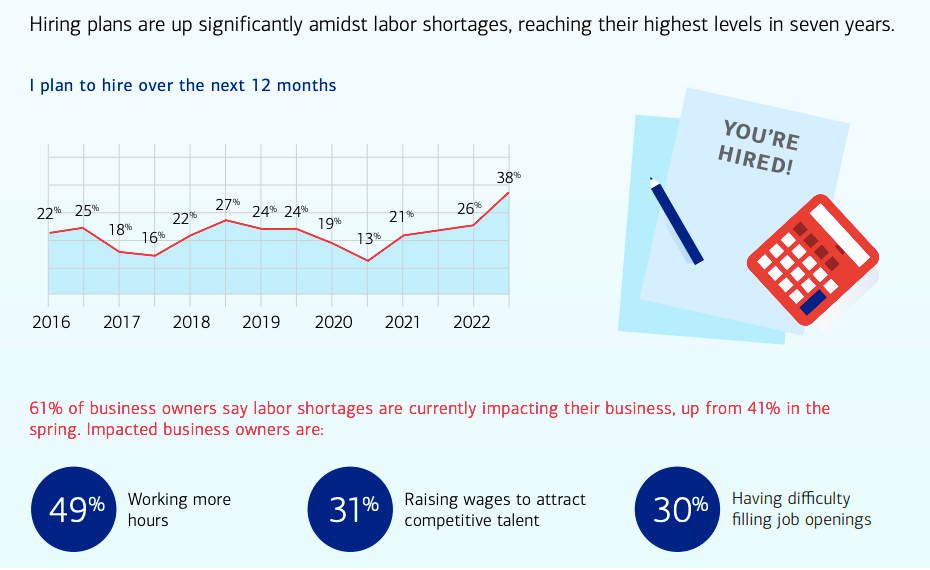
🤾♀️ much less work, extra leisure. The NY Fed these days seemed into how individuals have modified the approach by which they use their time for the rationale that emergence of COVID-19. From their weblog put up: “First, we uncover a substantial fall in time spent working; the decrease in hours labored away from residence is simply partially offset by an enhance in working at residence… Second, we see notable will enhance in leisure time and sleeping. The rise in leisure was significantly pronounced amongst youthful individuals, who reported spending extra time at social occasions, consuming at eating areas or bars, and exercising. Older age teams, alternatively, tended to allocate extra time to nonmarket work, similar to actions associated to childcare, the upkeep of the household, repairs, and meal preparation.“
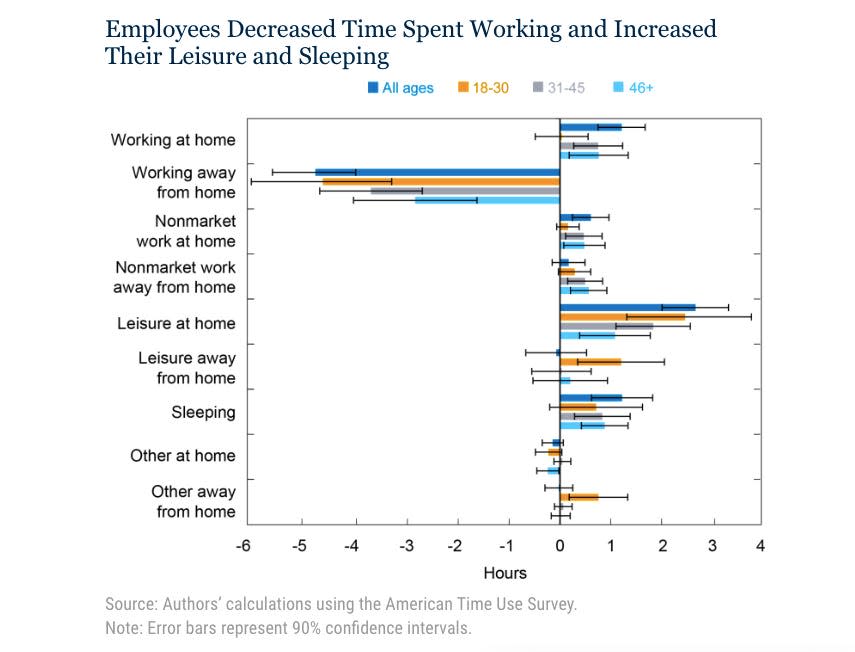
👶 Pandemic “baby bump.” From the NBER: “although fertility fees declined in 2020, these declines appear to mirror reductions in journey to the U.S. Childbearing inside the U.S. amongst international-born mothers declined immediately after lockdowns started — 9 months too quickly to mirror the pandemic’s outcomes on conceptions. We additionally discover that the COVID pandemic resulted in a small “baby bump” amongst U.S.-born mothers. The 2021 baby bump is the important important reversal in declining U.S. fertility fees since 2007 and was most pronounced for first births and women under age 25, which suggests the pandemic led some women to start out their households earlier. Above age 25, the new baby bump was additionally pronounced for women ages 30-34 and women with a faculty education, who had been extra inclined to be taught from working from residence.“

💰 Passive investing financial savings pile up. From S&P Dow Jones Indices: “amongst the numerous many advantages of indexing is its low value relative to lively administration. As indexing has grown, buyers have benefited considerably by saving on fees and avoiding underperformance. we’re ready to estimate the payment financial savings every 12 months by taking the distinction in expense ratios between lively and index equity mutual funds, and multiplying this distinction by the remaining worth of listed belongings for the S&P 500, S&P 4 hundred, and S&P 600. as quickly as we combination the outcomes, we observe that the cumulative financial savings in administration fees over the previous 25 years is $357 billion.“
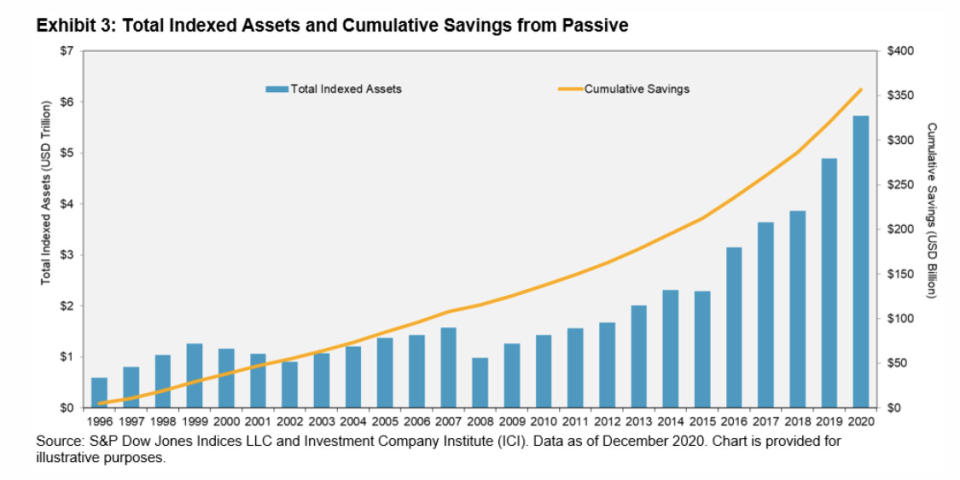
👍 Q3 earnings are beating expectations. From FactSet, “For Q3 2022 (with 20% of S&P 500 corporations reporting exact outcomes), seventy two% of S&P 500 corporations have reported a constructive EPS shock and 70% of S&P 500 corporations have reported a constructive income shock.“
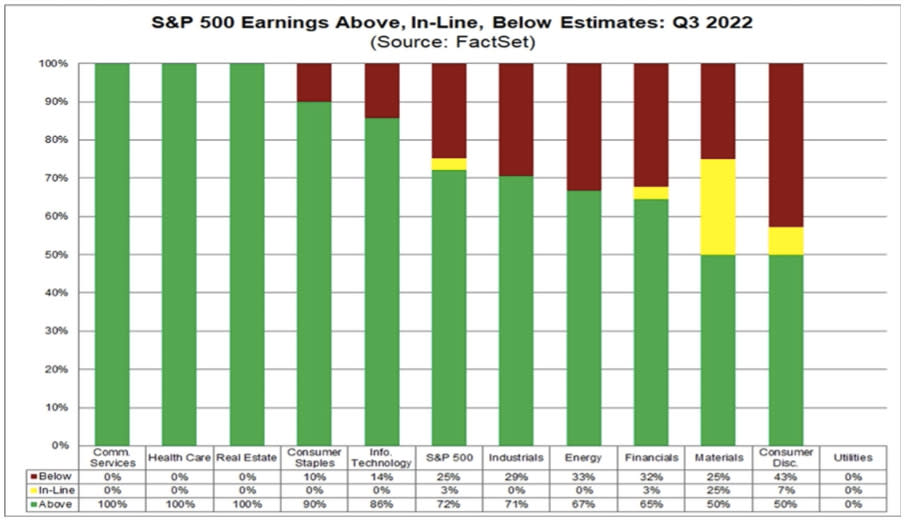
👎 however 2022 and 2023 earnings expectations are coming down. Analysts’ estimates for full 12 months earnings in 2022 and 2023 proceed to slip.
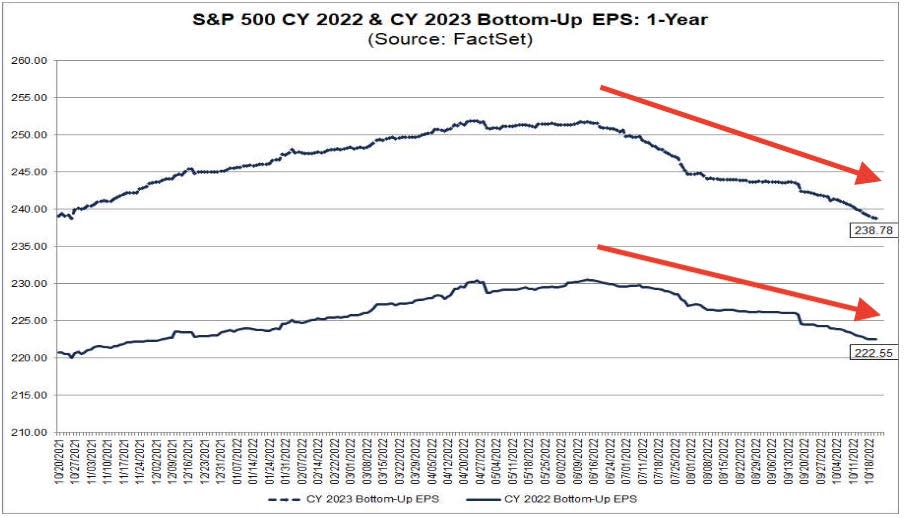
👍 however however: regardless of the downward revisions to 2022 and 2023 earnings estimates, analysts nonetheless count on earnings to develop 6.7% 12 months-over-12 months in 2022 and seven.three% in 2023.
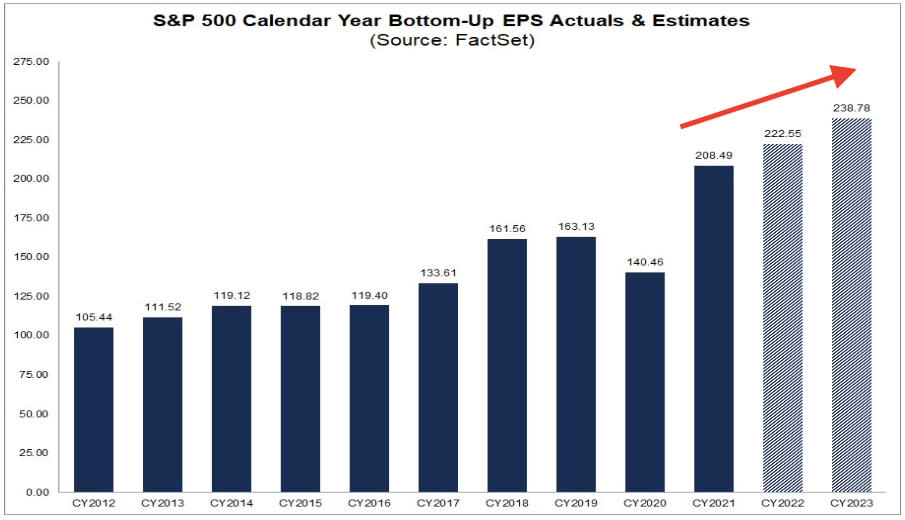
placing all of it collectively 🤔
Tighter monetary coverage from the Federal Reserve continues to have an unambiguously destructive affect on the housing market as greater mortgage fees cool exercise. however it’s additionally having the central financial institution’s supposed affect of cooling prices.
producers are cautious with regard to the outlook for the financial system, however exact exercise stays resilient.
Labor market indicators, in the meantime, proceed to maintain up.
sadly, the propensity needless to say segments of the financial system to develop is stopping inflation from coming down sooner. And combination measures of inflation stay very extreme.
So put together for issues to relax further on condition that the Fed is clearly resolute in its battle to get inflation under administration. Recession risks will proceed to intensify and analysts will proceed trimming their forecasts for earnings. For now, all of this makes for a conundrum for the inventory market and the financial system till we get “compelling proof” that inflation is certainly under administration.
the good information is there’s nonetheless a strong case to be made that any downturn obtained’t flip into financial calamity. that is corroborated by the very confirmed actuality that there’s been no collapse in industrial exercise or consumer spending, which has been supported by the resilient labor market and rising incomes.
And whereas markets have had a horrible 12 months thus far, the prolonged-run outlook for shares continues to be constructive.
For extra, try final week’s TKer macro crosscurrents »
1. In his quote, Druckenmiller speaks about his time as an analyst overlaying chemical compounds, a comparatively capital intensive enterprise. corporations on this enterprise pay money for very costly amenities and gear with the intention of using all of it for years. These prices don’t go away all by downturns. Labor prices are a bit fully different in that corporations have the selection to place off workers.
2. right here’s extra element from the convention Board: “The LEI is a predictive variable that anticipates (or “leads”) turning factors inside the enterprise cycle by round 7 months… The ten elements of The convention Board main financial Index® for the U.S. embrace: common weekly hours in manufacturing; common weekly preliminary claims for unemployment insurance coverage; producers’ new orders for consumer items and supplies; ISM® Index of latest Orders; producers’ new orders for nondefense capital items excluding plane orders; constructing permits for mannequin new private housing models; S&P 500® Index of inventory prices; main credit rating Index™; price of curiosity unfold (10-12 months Treasury bonds much less federal funds price); common consumer expectations for enterprise situations.”
A mannequin of this put up was initially printed on TKer.co.
–
extra from TKer:
be taught the latest monetary and enterprise information from Yahoo Finance
adjust to Yahoo Finance on Twitter, fb, Instagram, Flipboard, LinkedIn, and YouTube



0 Comments